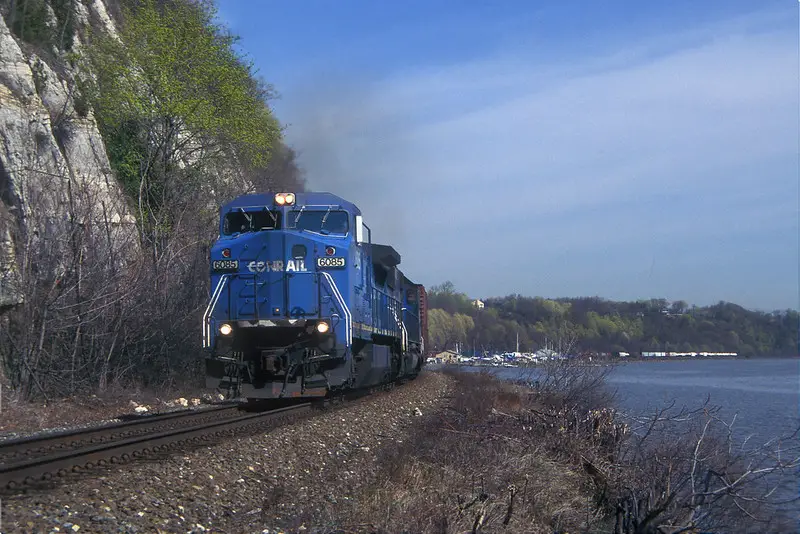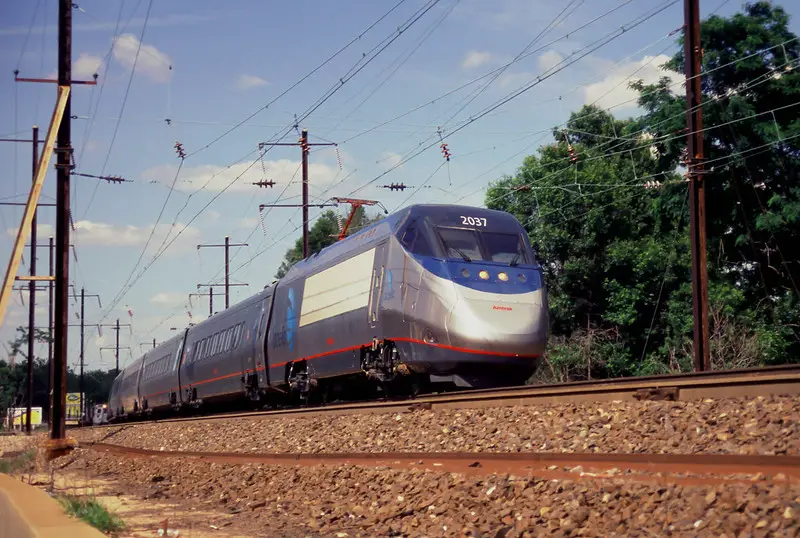Since the beginning of rail transportation in the early 19th century, trains have utilized various types of fuel. Initially, both coal and wood were utilized to power locomotives, however, electric and diesel power grew to prominence in the 20th century.
What do trains use for fuel? Trains use diesel, electric, and steam power for fuel. Upon the genesis of the railroad, steam was utilized, as it was the standard for many industries. In the early 20th century, electric and diesel-electric power technology advanced and became commonplace, and remains the primary means of powering trains today.
There are various differences between these modes of motive power. These modes of powering the railroad industry differ in various aspects, such as which type of fuel is utilized and how current is picked up by electric locomotives.
Steam Power
Dating back to the year 1812, the steam engine had been the pinnacle of transportation from the beginning of the industrial revolution in the early 19th century, until the mid-twentieth century. As steam technology improved throughout the years, locomotives grew larger and were both coal, oil and wood fired. Although they were the very first form of motive power to hit the rails, steam locomotives were quite complicated machines, as they had many moving parts, and required more manpower than any other types of motive power.
Oil fired steam locomotives became popular with many railroads, as many new locomotives were designed to burn oil, and others converted from coal. Oil fired locomotives, similar to coal, had to be heated with steam, and oftentimes utilized thick Bunker C oil, which resembled tar. Many railroads found it more efficient to burn oil rather than coal, as it was increasingly easier to fill the tender, and lacked the need for coal to be constantly stoked into the firebox. The utilization of oil for firing steam locomotives rose to prominence in the late twenties, as the substance was common due to increased automobile production.

There are various different parts in a steam locomotive, and many different mechanisms that must operate in unison to burn fuel efficiently. A steam locomotive works by igniting a fire in the locomotive’s boiler, which heats pipes inside the boiler, therefore raising the temperature of the water. The boiling water creates steam, which is sent down to the driving wheels through a pipe and into a pair of cylinders near the front of the locomotive, which turn the side-rods, thus, turning the wheels.
Oftentimes, the fuel, whether it be coal, wood, or oil, would be carried behind the locomotive in a railcar called a tender. However, in some instances, the coal is carried in compartments on the locomotive, such as a tank engine. However, these types of locomotives were utilized for yard switching or other light duties.
Diesel-Electric Power
The diesel-electric locomotive was introduced in the thirties, displacing many steam locomotives on various railroads’ premier trains. One of the first commercially successful diesel-electric locomotives was the Electro-Motive Division’s (EMD) E-series locomotives, a six axle locomotive built for passenger service. The striking streamlined look of the E-units made them a welcome addition to various railroads. Further success came for EMD when they unveiled their F-unit locomotives in the forties, beginning with the FT series. The four axle F-units were originally slated for primarily freight traffic, however, they became quite commonplace on various high profile trains such as the Santa Fe “Super Chief”.

Diesel locomotives are equipped with a powerful diesel prime mover, which generates current for the electric traction motors that power the axles. Diesel locomotives are more cost effective and efficient to operate, as they require less manpower and consume less fuel. Furthermore, because of various electrical connections, multiple locomotives can be operated from the lead unit by one crew. Diesel locomotives remain one of the most common types of locomotive currently in use throughout the world, as they are widely utilized in both passenger and freight service.
Diesel locomotives are also much lighter than steam, therefore, they produce less wear on vital infrastructure, such as the roadbed, rails, and ties. Furthermore, although steam locomotives cost less to build, the exponential maintenance costs deemed diesel more financially viable. Because of their low maintenance costs, diesels were more readily available than steam, in fact, steam locomotives are so maintenance heavy, they spent half their operating life out of service. Diesel locomotives are also more fuel efficient. According to CSX Transportation, one of the leading freight carriers in the United States, a diesel locomotive can travel 134 miles on a single gallon of fuel.
Gas-Turbine Power
Gas-turbine power emerged around the same time as the diesel locomotive, and operate similarly to diesels, as the gas turbine system generates power to the traction motors. First developed in France in the 1940s, the gas-turbine has been utilized in many parts of the world, however, its service was short lived. In North America, ALCO and GE developed various gas-turbine locomotives for Union Pacific to power their various transcontinental trains, however, they were far less fuel efficient than diesels. Thus, these locomotives were retired by the late sixties due to the rising cost of Bunker C oil used to fuel the locomotives.
Although the gas turbine locomotive saw little success in freight service, it was soon adopted for passenger services worldwide. It’s rise to fame in passenger services came in the seventies with the TGV 001 prototype, which led to the adoption of the gas turbine trainset in North America in the form of the UAC Turbotrain, and Amtrak’s RTG and RTL Turboliners, which were utilized in eastern Canada, and eastern and Midwestern United States.

In the United Kingdom, the gas turbine powered APT-E was instrumental in introducing high speed trains in Britain and around the world. Developed in the 1970s, the APT-E (Advanced Passenger Train Experimental), included a tilting technology in order to operate on the existing routes on the British Rail network, most of which was constructed in the late 19th century. The APT-E’s tilting mechanism allowed it to traverse tight turns at far greater speeds than a conventional train. The APT-E came to fruition due to the expense of reconstructing a dedicated high speed railway, or upgrading the existing infrastructure, however, due to the oil crisis in the seventies, the project was converted entirely to electric traction, focused on the West Coast Mainline. Gas turbine power is nearly extinct in railroading worldwide, in favor of the much more fuel efficient and reliable diesel-electric locomotive.
Electric Power
Electric trains rose to prominence in the early twentieth century, beginning in 1910 with the commencement of operations of the Hudson River Tunnels on the Pennsylvania Railroad’s Philadelphia-New York mainline. These tunnels allowed for direct access to New York’s bustling Manhattan. Due to the length of the tunnels, steam locomotives were prohibited due to the dense fumes. Thus the PRR developed the DD-1 electric locomotive to haul trains through the tunnel. As the twentieth century progressed, electric trains because popular with various high speed projects, such as the electrification of the PRR’s various mainlines. This led to the development of the storied GG1 locomotive, built by General Electric, and designed by famous designer Raymond Loewy.

As electric trains became more prominent, they became popular with high speed rail projects, most notably in Japan and France. Japan opened its Shinkansen service in 1964, when operations commenced on the Tokaido line. The success of the Shinkansen led to the development of high speed trains throughout the world, most notable, France’s TGV, which began operations in 1981 with the commencement of the Sud-Est line between Paris and Lyon. Electric trains are preferred when constructing a high speed rail network, as they are the most efficient, and have a superior power-to-weight ratio, and ease of maintenance.
Electric trains operates by collecting current either from a DC third rail or overhead power lines. This current (either AC or DC) then enters a transformer, which is then sent to a rectifier which convert the power to direct current. The DC current is then transferred to inverters, which transform the current back to alternating current. This three phase current is then sent to the traction motors, which then power the wheels. Unused current is then sent back to the power lines, increasing efficiency.
